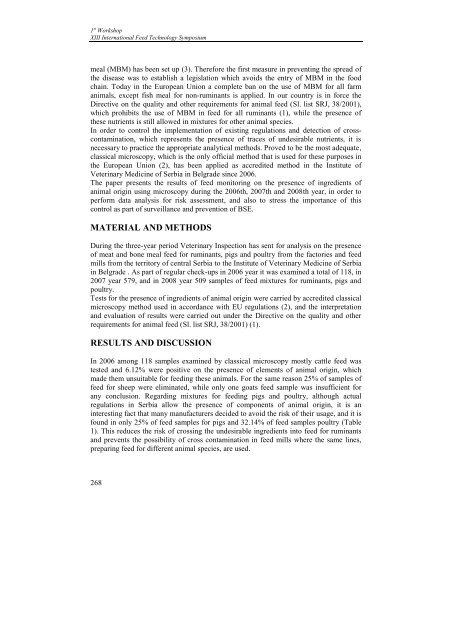Effects of dietary n-3 polyunsaturated fatty acids and ... - FINS
Effects of dietary n-3 polyunsaturated fatty acids and ... - FINS
Effects of dietary n-3 polyunsaturated fatty acids and ... - FINS
You also want an ePaper? Increase the reach of your titles
YUMPU automatically turns print PDFs into web optimized ePapers that Google loves.
1 st WorkshopXIII International Feed Technology Symposiummeal (MBM) has been set up (3). Therefore the first measure in preventing the spread <strong>of</strong>the disease was to establish a legislation which avoids the entry <strong>of</strong> MBM in the foodchain. Today in the European Union a complete ban on the use <strong>of</strong> MBM for all farmanimals, except fish meal for non-ruminants is applied. In our country is in force theDirective on the quality <strong>and</strong> other requirements for animal feed (Sl. list SRJ, 38/2001),which prohibits the use <strong>of</strong> MBM in feed for all ruminants (1), while the presence <strong>of</strong>these nutrients is still allowed in mixtures for other animal species.In order to control the implementation <strong>of</strong> existing regulations <strong>and</strong> detection <strong>of</strong> crosscontamination,which represents the presence <strong>of</strong> traces <strong>of</strong> undesirable nutrients, it isnecessary to practice the appropriate analytical methods. Proved to be the most adequate,classical microscopy, which is the only <strong>of</strong>ficial method that is used for these purposes inthe European Union (2), has been applied as accredited method in the Institute <strong>of</strong>Veterinary Medicine <strong>of</strong> Serbia in Belgrade since 2006.The paper presents the results <strong>of</strong> feed monitoring on the presence <strong>of</strong> ingredients <strong>of</strong>animal origin using microscopy during the 2006th, 2007th <strong>and</strong> 2008th year, in order toperform data analysis for risk assessment, <strong>and</strong> also to stress the importance <strong>of</strong> thiscontrol as part <strong>of</strong> surveillance <strong>and</strong> prevention <strong>of</strong> BSE.MATERIAL AND METHODSDuring the three-year period Veterinary Inspection has sent for analysis on the presence<strong>of</strong> meat <strong>and</strong> bone meal feed for ruminants, pigs <strong>and</strong> poultry from the factories <strong>and</strong> feedmills from the territory <strong>of</strong> central Serbia to the Institute <strong>of</strong> Veterinary Medicine <strong>of</strong> Serbiain Belgrade . As part <strong>of</strong> regular check-ups in 2006 year it was examined a total <strong>of</strong> 118, in2007 year 579, <strong>and</strong> in 2008 year 509 samples <strong>of</strong> feed mixtures for ruminants, pigs <strong>and</strong>poultry.Tests for the presence <strong>of</strong> ingredients <strong>of</strong> animal origin were carried by accredited classicalmicroscopy method used in accordance with EU regulations (2), <strong>and</strong> the interpretation<strong>and</strong> evaluation <strong>of</strong> results were carried out under the Directive on the quality <strong>and</strong> otherrequirements for animal feed (Sl. list SRJ, 38/2001) (1).RESULTS AND DISCUSSIONIn 2006 among 118 samples examined by classical microscopy mostly cattle feed wastested <strong>and</strong> 6.12% were positive on the presence <strong>of</strong> elements <strong>of</strong> animal origin, whichmade them unsuitable for feeding these animals. For the same reason 25% <strong>of</strong> samples <strong>of</strong>feed for sheep were eliminated, while only one goats feed sample was insufficient forany conclusion. Regarding mixtures for feeding pigs <strong>and</strong> poultry, although actualregulations in Serbia allow the presence <strong>of</strong> components <strong>of</strong> animal origin, it is aninteresting fact that many manufacturers decided to avoid the risk <strong>of</strong> their usage, <strong>and</strong> it isfound in only 25% <strong>of</strong> feed samples for pigs <strong>and</strong> 32.14% <strong>of</strong> feed samples poultry (Table1). This reduces the risk <strong>of</strong> crossing the undesirable ingredients into feed for ruminants<strong>and</strong> prevents the possibility <strong>of</strong> cross contamination in feed mills where the same lines,preparing feed for different animal species, are used.268
















